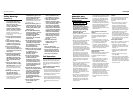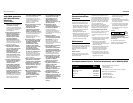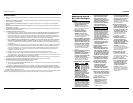
30 Sp
Manual de Instrucciones
Mantenimiento
Limpieza
Todas las piezas de plástico deben
limpiarse con un paño húmedo.
NUNCA use solventes para limpiar
piezas de plástico. Podrían disolverse o
dañar el material de alguna otra
manera.
La herramienta no funciona
En caso de que la herramienta no
funcione, asegúrese de que la batería
esté cargada e instalada en el taladro.
Servicio a la batería
La batería que se proporciona con este
taladro se descargará sola y perderá
algo de su capacidad con el paso del
tiempo. Por lo tanto, si se almacena sin
usar durante un período de tiempo
prolongado, puede que sea necesario
recargarla antes de usarla. Para
obtener el mayor rendimiento de sus
baterías, se recomienda recargar la
batería cada 2 ó 3 meses y cuando se
recargue, se debe retirar la batería del
cargador después de 2 ó 3 horas de
carga.
Remoción / reemplazo del
portabrocas
Si fuera necesario reemplazar el
portabrocas, siga los pasos siguientes
para hacerlo:
• Retire la batería del taladro.
• Gire el collar de embrague hasta que
el símbolo de broca quede alineado
con la flecha que se encuentra en la
parte superior de la carcasa del
taladro.
• Abra completamente las mordazas
del portabrocas desatornillando el
manguito del portabrocas hacia la
izquierda (cuando se ve el
portabrocas desde su extremo).
• Ubique el tornillo izquierdo dentro
del portabrocas y con la punta de
destornillador adecuada quite este
tornillo girándolo hacia la derecha.
• Introduzca el brazo corto de una
llave hexagonal o Allen de 3/8 pulg.
dentro del portabrocas y apriete las
mordazas del portabrocas sobre las
partes planas de esta llave.
• Con un martillo o similar, golpee el
brazo largo de la llave con un golpe
seco de modo que el portabrocas
gire hacia la izquierda.
• Una vez que haya aflojado el
portabrocas, retire la llave y
desatornille el portabrocas de su
vástago.
• Para cambiar el portabrocas por
otro, invierta los pasos descritos
anteriormente. Siempre mantenga
las roscas del vástago, las roscas del
portabrocas y el tornillo sujetador
sin residuos.
Servicio
El servicio a esta herramienta debe
ser realizado únicamente por
personal calificado en reparación
y por un CENTRO DE SERVICIO
AUTORIZADO. El servicio o
mantenimiento realizados por
personas no calificadas puede
provocar riesgo de lesiones.
Para obtener información con relación
al funcionamiento o reparación de este
producto, sírvase llamar al
1-800-424-8936.
Para Ordenar Repuestos o Asistencia Técnica, Sírvase Llamar al
Distribuidor Más Cercano a Su Domicilio
S’il vous plaît fournir l’information suivante:
- Número del modelo
- Código impreso
- Descripción y número del repuesto según la lista de
repuestos
Número del
Descripción Repuesto
Dirija toda la correspondencia a:
Campbell Hausfeld
Attn: Parts Department
100 Production Drive
Harrison, OH 45030 U.S.A .
Cargador – 19,2V DG029600AV
Batería – 19,2V DG201900AV
Portabroca – 3/8 po DG029900AV
Tornillo de fijación SX173400AV
Caja DG030000AV
3
DG201900CK
General Power Tool
Safety Warnings
(Continued)
d)Remove any adjusting key or
wrench before turning the
power tool on. A wrench or a
key left attached to a rotating
part of the power tool may
result in personal injury.
e)Do not overreach. Keep
proper footing and balance
at all times. This enables better
control of the power tool in
unexpected situations.
f) Dress properly. Do not wear
loose clothing or jewelry.
Keep your hair, clothing and
gloves away from moving
parts. Loose clothes, jewelry or
long hair can be caught in
moving parts.
g)If devices are provided for
the connection of dust
extraction and collection
facilities, ensure these are
connected and properly used.
Use of dust collection can reduce
dust-related hazards.
h)CALIFORNIA PROPOSITION 65
You can create dust
when you cut,
sand, drill or grind
materials such as
wood, paint, metal,
concrete, cement,
or other masonry. This dust often
contains chemicals known to
cause cancer, birth defects, or
other reproductive harm. Wear
protective gear.
i)
This product or its power cord
contains lead, a chemical known
to the State of California to
cause cancer and birth defects or
other reproductive harm. Wash
hands after handling.
j) Some wood contains
preservatives which can be
toxic. Take extra care to
prevent inhalation and skin
contact when working with
these materials. Request and
follow all safety information
available from your material
supplier.
k)
Do not misuse this product.
Excessive exposure to vibration,
work in awkward positions, and
repetitive work motions can
cause injury to hands and arms.
Stop using any tool if discomfort,
numbness, tingling, or pain
occur, and consult a physician.
l) Always work in a well-
ventilated area. Wear an
OSHA-approved dust mask.
m) Keep hands away from
rotating parts.
n)Use clamps or another
practical way to secure the
workpiece to a stable
platform. Never hold work in
your hand, lap, or against
other parts of your body
when drilling.
o) Before using the battery
charger, read all instructions
on the charger, battery, and
product.
p)Do not attempt to
disassemble the battery or
remove any component
projecting from the battery
terminals. Fire or injury may
result.
4) Power tool use and care
a)Do not force the power tool.
Use the correct power tool for
your application. The correct
power tool will do the job better
and safer at the rate for which it
was designed.
b)Do not use the power tool if
the switch does not turn it on
and off. Any power tool that
cannot be controlled with the
switch is dangerous and must be
repaired.
c) Disconnect the plug from the
power source and/or the
battery pack from the power
tool before making any
adjustments, changing
accessories, or storing power
tools. Such preventive safety
measures reduce the risk of
starting the power tool
accidentally.
d)Store idle power tools out of
the reach of children and do
not allow persons unfamiliar
with the power tool or these
instructions to operate the
power tool. Power tools are
dangerous in the hands of
untrained users.
e)Maintain power tools. Check
for misalignment or binding
of moving parts, breakage of
parts and any other condition
that may affect the power
tool’s operation. If damaged,
have the power tool repaired
before use. Many accidents are
caused by poorly maintained
power tools.
f) Keep cutting tools sharp and
clean. Properly maintained
cutting tools with sharp cutting
edges are less likely to bind and
are easier to control.
g)Use the power tool,
accessories and tool bits etc.
in accordance with these
instructions, taking into
account the working
conditions and the work to
be performed. Use of the
power tool for operations
different from those intended
could result in a hazardous
situation.


















